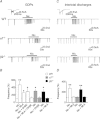Regulation of hippocampal inhibitory circuits by nicotinic acetylcholine receptors
- PMID: 22124144
- PMCID: PMC3381299
- DOI: 10.1113/jphysiol.2011.220095
Regulation of hippocampal inhibitory circuits by nicotinic acetylcholine receptors
Abstract
The hippocampal network comprises a large variety of locally connected GABAergic interneurons exerting a powerful control on network excitability and which are responsible for the oscillatory behaviour crucial for information processing. GABAergic interneurons receive an important cholinergic innervation from the medial septum-diagonal band complex of the basal forebrain and are endowed with a variety of muscarinic and nicotinic acetylcholine receptors (mAChRs and nAChRs) that regulate their activity. Deficits in the cholinergic system lead to the impairment of high cognitive functions, which are particularly relevant in neurodegenerative pathologies such as Alzheimer's and Parkinson's diseases as well as in schizophrenia. Here, we highlight some recent advances in the mechanisms by which cholinergic signalling via nAChRs regulates local inhibitory circuits in the hippocampus, early in postnatal life and in adulthood. We also discuss recent findings concerning the functional role of nAChRs in controlling short- and long-term modifications of synaptic efficacy. Insights into these processes may provide new targets for the therapeutic control of pathological conditions associated with cholinergic dysfunctions.
Figures



Similar articles
-
Cholinergic receptors: functional role of nicotinic ACh receptors in brain circuits and disease.Pflugers Arch. 2013 Apr;465(4):441-50. doi: 10.1007/s00424-012-1200-1. Epub 2013 Jan 11. Pflugers Arch. 2013. PMID: 23307081 Free PMC article. Review.
-
Nicotinic acetylcholine receptor alpha7 and alpha4beta2 subtypes differentially control GABAergic input to CA1 neurons in rat hippocampus.J Neurophysiol. 2001 Dec;86(6):3043-55. doi: 10.1152/jn.2001.86.6.3043. J Neurophysiol. 2001. PMID: 11731559
-
Activation of nicotinic acetylcholine receptors enhances a slow calcium-dependent potassium conductance and reduces the firing of stratum oriens interneurons.Eur J Neurosci. 2009 Sep;30(6):1011-22. doi: 10.1111/j.1460-9568.2009.06914.x. Epub 2009 Sep 4. Eur J Neurosci. 2009. PMID: 19735287
-
Reversible inhibition of GABAA receptors by alpha7-containing nicotinic receptors on the vertebrate postsynaptic neurons.J Physiol. 2007 Mar 15;579(Pt 3):753-63. doi: 10.1113/jphysiol.2006.124578. Epub 2007 Jan 4. J Physiol. 2007. PMID: 17204496 Free PMC article.
-
Nicotinic ACh receptors in the hippocampus: role in excitability and plasticity.Nicotine Tob Res. 2012 Nov;14(11):1249-57. doi: 10.1093/ntr/nts091. Epub 2012 Apr 3. Nicotine Tob Res. 2012. PMID: 22472168 Free PMC article. Review.
Cited by
-
Recurring Cholinergic Inputs Induce Local Hippocampal Plasticity through Feedforward Disinhibition.eNeuro. 2022 Aug 25;9(5):ENEURO.0389-21.2022. doi: 10.1523/ENEURO.0389-21.2022. Online ahead of print. eNeuro. 2022. PMID: 36028329 Free PMC article.
-
Is the Antidepressant Activity of Selective Serotonin Reuptake Inhibitors Mediated by Nicotinic Acetylcholine Receptors?Molecules. 2021 Apr 8;26(8):2149. doi: 10.3390/molecules26082149. Molecules. 2021. PMID: 33917953 Free PMC article. Review.
-
The novel α7β2-nicotinic acetylcholine receptor subtype is expressed in mouse and human basal forebrain: biochemical and pharmacological characterization.Mol Pharmacol. 2014 Sep;86(3):306-17. doi: 10.1124/mol.114.093377. Epub 2014 Jul 7. Mol Pharmacol. 2014. PMID: 25002271 Free PMC article.
-
The Theta Rhythm of the Hippocampus: From Neuronal and Circuit Mechanisms to Behavior.Front Cell Neurosci. 2021 Mar 4;15:649262. doi: 10.3389/fncel.2021.649262. eCollection 2021. Front Cell Neurosci. 2021. PMID: 33746716 Free PMC article.
-
A Role for the Transcription Factor Nk2 Homeobox 1 in Schizophrenia: Convergent Evidence from Animal and Human Studies.Front Behav Neurosci. 2016 Mar 30;10:59. doi: 10.3389/fnbeh.2016.00059. eCollection 2016. Front Behav Neurosci. 2016. PMID: 27064909 Free PMC article.
References
-
- Alkondon M, Albuquerque EX. Nicotinic acetylcholine receptorα7 and α4β2 subtypes differentially control GABAergic input to CA1 neurons in rat hippocampus. J Neurophysiol. 2001;86:3043–3055. - PubMed
-
- Alkondon M, Albuquerque EX. The nicotinic acetylcholine receptor subtypes and their function in the hippocampus and cerebral cortex. Prog Brain Res. 2004;145:109–120. - PubMed
-
- Alkondon M, Braga MF, Pereira EF, Maelicke A, Albuquerque EX. α7 nicotinic acetylcholine receptors and modulation of GABAergic synaptic transmission in the hippocampus. Eur J Pharmacol. 2000;393:59–67. - PubMed
-
- Alkondon M, Pereira EF, Albuquerque EX. α-Bungarotoxin- and methyllycaconitine-sensitive nicotinic receptors mediate fast synaptic transmission in interneurons of rat hippocampal slices. Brain Res. 1998;810:257–263. - PubMed
Publication types
MeSH terms
Substances
LinkOut - more resources
Full Text Sources

